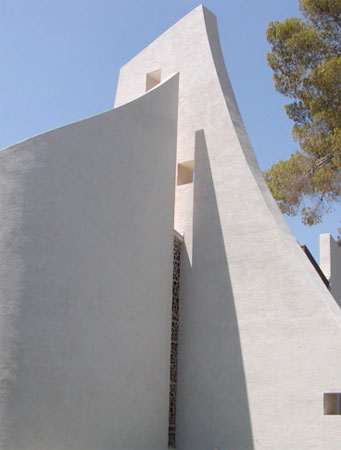 |
Arizona State Mental Hospital Chapel
2500 East Van Buren Street
Phoenix, Arizona 85008
(602) 244-1331
Story by Walt Lockley
|
The Arizona state mental hospital has been here at 24th Street and Van Buren since the 1880s, although the oldest building, from which the infamous trunk-murderer Winnie Ruth Judd escaped from twelve or fourteen times, dates from 1912 and now stands vacant. There are eight or nine mismatched buildings from different eras on campus with lots of empty space between. All of them are behind perimeter razor wire. Some of them are extra-secure. There's a juvenile facility. Make no mistake: this campus has seen and heard a lot of pain since in the 1880s. 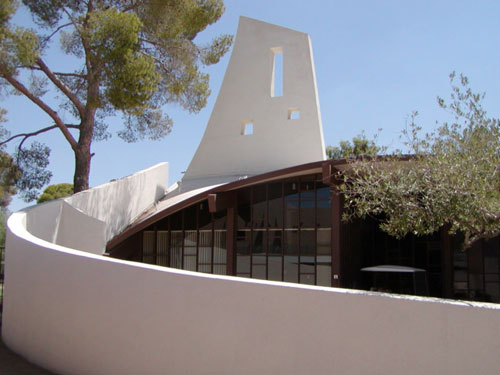 The CEO here is John Cooper, a man with a courtly southern accent and a gray mustache, who runs his errands on a golf cart, and who is as kind and patient as you'd want the head of a mental hospital to be. With good humor he briefs me on his political challenges getting proper funding from the state, and keeping difficult jobs properly staffed, but he doesn't dwell on his problems. His last job had been at Roswell, New Mexico, yes at THAT facility, and so he handled all kinds of calls from people who fingered him as part of the vast government cover-up.
The CEO here is John Cooper, a man with a courtly southern accent and a gray mustache, who runs his errands on a golf cart, and who is as kind and patient as you'd want the head of a mental hospital to be. With good humor he briefs me on his political challenges getting proper funding from the state, and keeping difficult jobs properly staffed, but he doesn't dwell on his problems. His last job had been at Roswell, New Mexico, yes at THAT facility, and so he handled all kinds of calls from people who fingered him as part of the vast government cover-up.
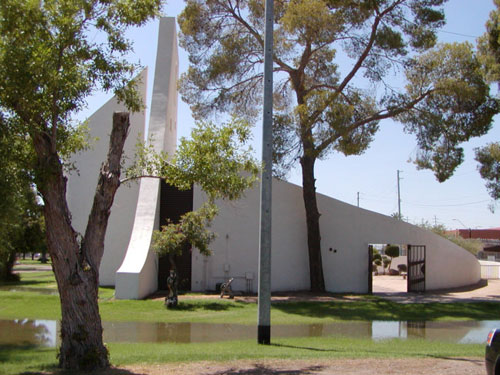 So after a bumpy golf cart ride, off towards the southwestern corner of campus, on its own lawn, we come to the chapel. John mentions Frank Lloyd Wright hopefully; that's been the rumor. The lineage is actually Weaver and Drover, 1963. The designer for W&D was Willard MacGonigle, who worked for them briefly before moving to the Morro Bay area to teach. This is his only known building in Phoenix.
So after a bumpy golf cart ride, off towards the southwestern corner of campus, on its own lawn, we come to the chapel. John mentions Frank Lloyd Wright hopefully; that's been the rumor. The lineage is actually Weaver and Drover, 1963. The designer for W&D was Willard MacGonigle, who worked for them briefly before moving to the Morro Bay area to teach. This is his only known building in Phoenix.
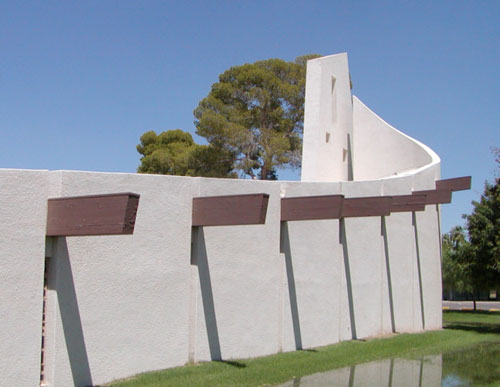 It is crisp, white, complicated. There's a very good feeling. It's a beautiful building, to begin with, like a puzzle or a seashell, a swooping, retro-futuristic sculpture in splendid condition, seemingly wrapped up in clingfilm in 1967. Where an ordinary building is stacked together from flat planes, this one is composed of a few sweeping, interlocking, curving planes that define the interior spaces, then they peak for a sort of integrated steeple like a white fin, and then swing out to form enclosing walls for two small gardens on the west and north sides. The roof is held up by a series of seven big conspicuous lam-beams with their own curves and rhythm. On the south wall they stick out like vigas. Inside they're painted orange.
It is crisp, white, complicated. There's a very good feeling. It's a beautiful building, to begin with, like a puzzle or a seashell, a swooping, retro-futuristic sculpture in splendid condition, seemingly wrapped up in clingfilm in 1967. Where an ordinary building is stacked together from flat planes, this one is composed of a few sweeping, interlocking, curving planes that define the interior spaces, then they peak for a sort of integrated steeple like a white fin, and then swing out to form enclosing walls for two small gardens on the west and north sides. The roof is held up by a series of seven big conspicuous lam-beams with their own curves and rhythm. On the south wall they stick out like vigas. Inside they're painted orange.
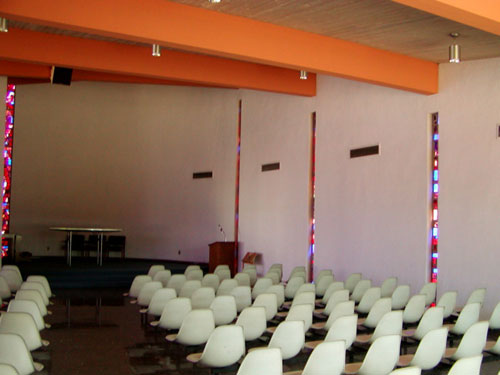 Something tells me the lads at Weaver and Drover kept up on their magazine subscriptions -- or let's say they actively sought inspiration. Several of their forty Valley National Bank branches are outright homages to other major buildings The inspiration for this chapel might have been the biomorphic concrete experiments of Le Corbusier or Breuer from the late 1950s, although I can't quite put my finger on the exact reference. The wall of luminous multicolored stained glass on the north side seems like another reference. The steeple 'fin' is punctured with three stylish rectangles, and that seems like another reference. References or not, homages or not, the chapel here deserves its own Modernist street cred for its complete departure from historical styles, which feels like a departure from history, which makes it feel out-of-time.
Something tells me the lads at Weaver and Drover kept up on their magazine subscriptions -- or let's say they actively sought inspiration. Several of their forty Valley National Bank branches are outright homages to other major buildings The inspiration for this chapel might have been the biomorphic concrete experiments of Le Corbusier or Breuer from the late 1950s, although I can't quite put my finger on the exact reference. The wall of luminous multicolored stained glass on the north side seems like another reference. The steeple 'fin' is punctured with three stylish rectangles, and that seems like another reference. References or not, homages or not, the chapel here deserves its own Modernist street cred for its complete departure from historical styles, which feels like a departure from history, which makes it feel out-of-time.
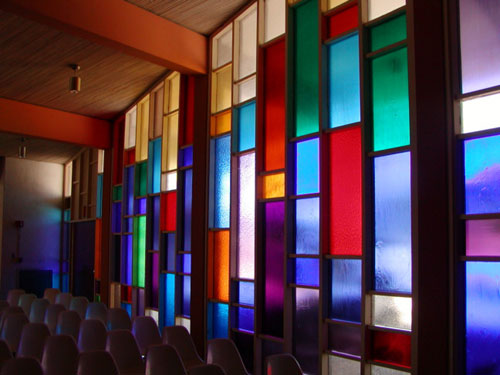 Then there's the effectiveness of this design for its audience. I know of only one study on the psychology of architecture on the mentally ill, and its findings suggest that conservative predictability in building design is best. "People whose perception is affected by their illness can experience real distress when faced with ambiguous situations." A bending, curving, warping, discontinuous chapel may not have been the best idea. Beautiful, but maybe a bad idea. Maybe a terrible idea. On the other hand, the experiment was done as part of Humphrey Osmond's notorious Weyburn experiments, the researcher had ingested LSD to approximate mental illness, it's only one study, and in any case it's too late now.
Then there's the effectiveness of this design for its audience. I know of only one study on the psychology of architecture on the mentally ill, and its findings suggest that conservative predictability in building design is best. "People whose perception is affected by their illness can experience real distress when faced with ambiguous situations." A bending, curving, warping, discontinuous chapel may not have been the best idea. Beautiful, but maybe a bad idea. Maybe a terrible idea. On the other hand, the experiment was done as part of Humphrey Osmond's notorious Weyburn experiments, the researcher had ingested LSD to approximate mental illness, it's only one study, and in any case it's too late now.
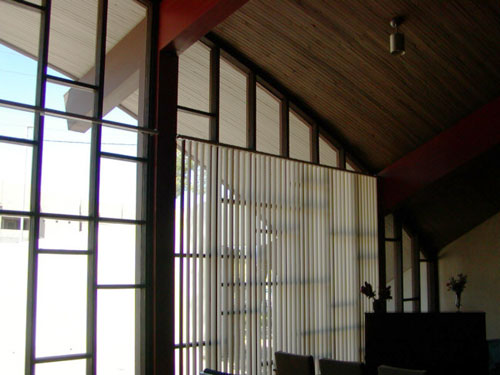 Then, there's the building condition -- pristine, in a quiet spot on campus, the whites white, the glass clean, the grass green and watered, the floor polished. It's used for occasional meetings, that's all. Few inmates use the chapel although they're welcome to. As a state-run non-denominational facility and carefully free of any particular symbolism, it doesn't feel particularly holy, but it does feel peaceful and complete. If any building seems protected from the slings and arrows of ordinary wear and tear it's this one.
The building is largely visible from the corner of 24th Street and Van Buren. (Although Van Buren has improved lately, it's still a good idea to be aware of your surroundings.)
Then, there's the building condition -- pristine, in a quiet spot on campus, the whites white, the glass clean, the grass green and watered, the floor polished. It's used for occasional meetings, that's all. Few inmates use the chapel although they're welcome to. As a state-run non-denominational facility and carefully free of any particular symbolism, it doesn't feel particularly holy, but it does feel peaceful and complete. If any building seems protected from the slings and arrows of ordinary wear and tear it's this one.
The building is largely visible from the corner of 24th Street and Van Buren. (Although Van Buren has improved lately, it's still a good idea to be aware of your surroundings.)
|
 The CEO here is John Cooper, a man with a courtly southern accent and a gray mustache, who runs his errands on a golf cart, and who is as kind and patient as you'd want the head of a mental hospital to be. With good humor he briefs me on his political challenges getting proper funding from the state, and keeping difficult jobs properly staffed, but he doesn't dwell on his problems. His last job had been at Roswell, New Mexico, yes at THAT facility, and so he handled all kinds of calls from people who fingered him as part of the vast government cover-up.
The CEO here is John Cooper, a man with a courtly southern accent and a gray mustache, who runs his errands on a golf cart, and who is as kind and patient as you'd want the head of a mental hospital to be. With good humor he briefs me on his political challenges getting proper funding from the state, and keeping difficult jobs properly staffed, but he doesn't dwell on his problems. His last job had been at Roswell, New Mexico, yes at THAT facility, and so he handled all kinds of calls from people who fingered him as part of the vast government cover-up.
 So after a bumpy golf cart ride, off towards the southwestern corner of campus, on its own lawn, we come to the chapel. John mentions Frank Lloyd Wright hopefully; that's been the rumor. The lineage is actually Weaver and Drover, 1963. The designer for W&D was Willard MacGonigle, who worked for them briefly before moving to the Morro Bay area to teach. This is his only known building in Phoenix.
So after a bumpy golf cart ride, off towards the southwestern corner of campus, on its own lawn, we come to the chapel. John mentions Frank Lloyd Wright hopefully; that's been the rumor. The lineage is actually Weaver and Drover, 1963. The designer for W&D was Willard MacGonigle, who worked for them briefly before moving to the Morro Bay area to teach. This is his only known building in Phoenix.
 It is crisp, white, complicated. There's a very good feeling. It's a beautiful building, to begin with, like a puzzle or a seashell, a swooping, retro-futuristic sculpture in splendid condition, seemingly wrapped up in clingfilm in 1967. Where an ordinary building is stacked together from flat planes, this one is composed of a few sweeping, interlocking, curving planes that define the interior spaces, then they peak for a sort of integrated steeple like a white fin, and then swing out to form enclosing walls for two small gardens on the west and north sides. The roof is held up by a series of seven big conspicuous lam-beams with their own curves and rhythm. On the south wall they stick out like vigas. Inside they're painted orange.
It is crisp, white, complicated. There's a very good feeling. It's a beautiful building, to begin with, like a puzzle or a seashell, a swooping, retro-futuristic sculpture in splendid condition, seemingly wrapped up in clingfilm in 1967. Where an ordinary building is stacked together from flat planes, this one is composed of a few sweeping, interlocking, curving planes that define the interior spaces, then they peak for a sort of integrated steeple like a white fin, and then swing out to form enclosing walls for two small gardens on the west and north sides. The roof is held up by a series of seven big conspicuous lam-beams with their own curves and rhythm. On the south wall they stick out like vigas. Inside they're painted orange.
 Something tells me the lads at Weaver and Drover kept up on their magazine subscriptions -- or let's say they actively sought inspiration. Several of their forty Valley National Bank branches are outright homages to other major buildings The inspiration for this chapel might have been the biomorphic concrete experiments of Le Corbusier or Breuer from the late 1950s, although I can't quite put my finger on the exact reference. The wall of luminous multicolored stained glass on the north side seems like another reference. The steeple 'fin' is punctured with three stylish rectangles, and that seems like another reference. References or not, homages or not, the chapel here deserves its own Modernist street cred for its complete departure from historical styles, which feels like a departure from history, which makes it feel out-of-time.
Something tells me the lads at Weaver and Drover kept up on their magazine subscriptions -- or let's say they actively sought inspiration. Several of their forty Valley National Bank branches are outright homages to other major buildings The inspiration for this chapel might have been the biomorphic concrete experiments of Le Corbusier or Breuer from the late 1950s, although I can't quite put my finger on the exact reference. The wall of luminous multicolored stained glass on the north side seems like another reference. The steeple 'fin' is punctured with three stylish rectangles, and that seems like another reference. References or not, homages or not, the chapel here deserves its own Modernist street cred for its complete departure from historical styles, which feels like a departure from history, which makes it feel out-of-time.
 Then there's the effectiveness of this design for its audience. I know of only one study on the psychology of architecture on the mentally ill, and its findings suggest that conservative predictability in building design is best. "People whose perception is affected by their illness can experience real distress when faced with ambiguous situations." A bending, curving, warping, discontinuous chapel may not have been the best idea. Beautiful, but maybe a bad idea. Maybe a terrible idea. On the other hand, the experiment was done as part of Humphrey Osmond's notorious Weyburn experiments, the researcher had ingested LSD to approximate mental illness, it's only one study, and in any case it's too late now.
Then there's the effectiveness of this design for its audience. I know of only one study on the psychology of architecture on the mentally ill, and its findings suggest that conservative predictability in building design is best. "People whose perception is affected by their illness can experience real distress when faced with ambiguous situations." A bending, curving, warping, discontinuous chapel may not have been the best idea. Beautiful, but maybe a bad idea. Maybe a terrible idea. On the other hand, the experiment was done as part of Humphrey Osmond's notorious Weyburn experiments, the researcher had ingested LSD to approximate mental illness, it's only one study, and in any case it's too late now.
 Then, there's the building condition -- pristine, in a quiet spot on campus, the whites white, the glass clean, the grass green and watered, the floor polished. It's used for occasional meetings, that's all. Few inmates use the chapel although they're welcome to. As a state-run non-denominational facility and carefully free of any particular symbolism, it doesn't feel particularly holy, but it does feel peaceful and complete. If any building seems protected from the slings and arrows of ordinary wear and tear it's this one.
The building is largely visible from the corner of 24th Street and Van Buren. (Although Van Buren has improved lately, it's still a good idea to be aware of your surroundings.)
Then, there's the building condition -- pristine, in a quiet spot on campus, the whites white, the glass clean, the grass green and watered, the floor polished. It's used for occasional meetings, that's all. Few inmates use the chapel although they're welcome to. As a state-run non-denominational facility and carefully free of any particular symbolism, it doesn't feel particularly holy, but it does feel peaceful and complete. If any building seems protected from the slings and arrows of ordinary wear and tear it's this one.
The building is largely visible from the corner of 24th Street and Van Buren. (Although Van Buren has improved lately, it's still a good idea to be aware of your surroundings.)
